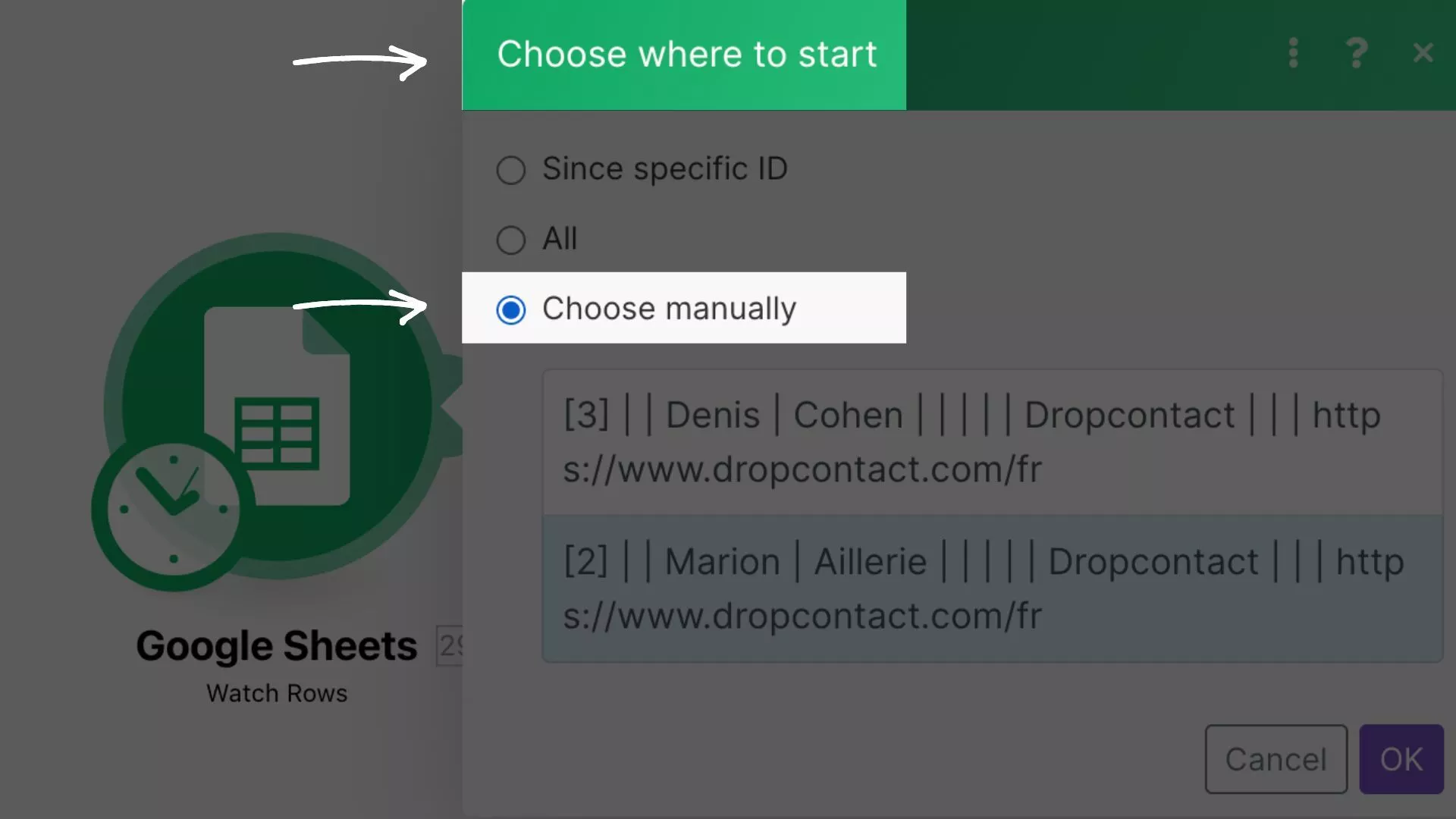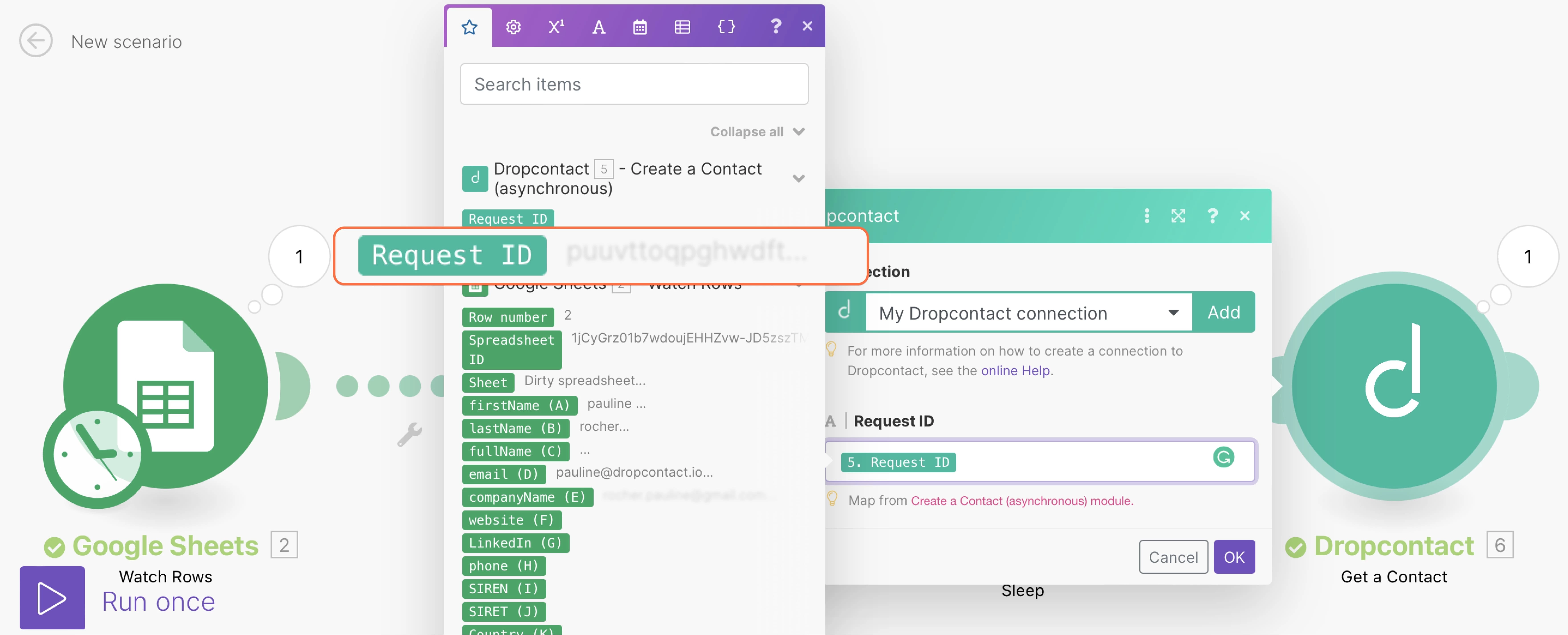Have you ever calculated how much time you spend cleaning and enriching your contact base per day? 🙄
I'll give you the answer right away: About 1 hour per day, or 5 hours per week, or 22 hours per month¹.
¹2018 Hubspot study of 6,200 people
It's a little scary to realize this waste of time in your prospecting, isn't it? Automation will save the day!
You will now be able to realize your dreams to focus on your real added value thanks to the integration of Dropcontact in Make.
Dropcontact finds professional emails, enriches them, and updates your prospect data, without having to spend hours on it… The essential tool! 💚
For those who use Zapier, it's here 👉 [Tuto] : Enrich and clean your B2B database with a Zapier automation
And those who are more on the n8n side, it's this way 👉🏼 Leverage your Sales Automation with n8n
Make: Automate your growth hacking workflow
Make is one of the most powerful automation platforms on the SaaS market.
The platform is compatible with more than 250 SaaS services and allows you to customize your own webhooks and automation processes: you do what you want!
Good news : There is a freemium version.
In short, an accessible platform that allows you to have fun in your job 💚
Dropcontact: enriching your BtoB lead base
A first name, last name, website and/or company is enough for Dropcontact to provide a verified professional email address. But that's not all, Dropcontact enriches, cleans your prospect and customer contacts, and identifies and merges duplicates.
Integrating Dropcontact into your Sales and Marketing tools does not require any technical skills ✌🏻
The free trial allows you to test the tool freely by processing 100 contacts for free. 🎁
A few prerequisites before starting the automatic enrichment of your B2B leads
- Have a Google Sheet file:
- containing at least one line with a name, first name, website, and company name
- shared to "everyone with the link" with edit access

- Create your Dropcontact account. Registration is completely free and you can test the solution (without entering your credit card data!) to convince yourself.
- Create your Make account (it's free and quick).
- Add Make add-on in Google Sheet (📎 Follow the tutorial).
Tutorial : Automate your B2B database enrichment with Make and Dropcontact, without development
But how? Don't panic, we'll explain everything to you, using a concrete example.
Dropcontact is natively integrated into Make for an easier enrichment workflow! 😌
Let’s go ! 🚀
1 - Create a new Make scenario
This scenario will connect your Google Sheet containing your contact data, with Dropcontact, which will clean and enrich it automatically, in a new tab of your file.

2 - Add first Google Sheet module, "Watch Rows" trigger
- Connect your Google account
- Select your Google Sheets file and the worksheet on which you want to retrieve the data to enrich
3 - Add a Dropcontact module "Create a Contact (asynchronous)"
- Map fields with contact information
💡 Launch a run each time a module is added to test as you go along.
Before starting a run, manually choose the specific line to start with:

4 - Add a delay "Sleep"
Then add a tool: "Sleep" Action. To maximize Dropcontact success rates, specify a delay of 50 seconds*. 😴
*⚠️ Why this 50 second delay? Dropcontact does not have a stored and nominative database, but enriches your data using algorithms and its own servers. This is why Dropcontact is the only 100% GDPR compliant solution.
5 - Specify a "Get a Contact" Dropcontact module
- Select the Request ID obtained thanks to the previous Dropcontact module

💡 launch another run to test your workflow.
6 - Get access to your cleaned and enriched file!
One last step before the success of your prospecting and your success 🤩
Add a last Google Sheet module, action “Add a row”
- Connexion : Connect you Google account again
- Spreadsheat : Select the Google Sheet where you want to find your cleaned and enriched data
- Sheet name : The specific tab
- Table contains headers : YES
Download the Dropcontact template here (just copy and paste the headers into your own file)
- Values : For each item, add the corresponding variable available in the “Dropcontact - Get a Contact” submenu
Confirm. And There you go !
You have just created your own workflow in less than 10 minutes (only once), to save 10 hours of tedious tasks every week.
⚠️ Dropcontact modules directly integrated into make may not retrieve all of the company's legal information (turnover, number of employees, siret, siren, VAT number). For full enrichment, follow our tutorial below 👇
1 - Create a new Make scenario

2 - Add first Google Sheet module, “Watch Changes” trigger
At this point, copy-paste the link provided on the Make add-on of your Google Sheet > Add-on > Make > Settings > Webhook URL
💡 Set up the schedule every day to optimize the use of your credits if you regularly work on your file.
💡 Share your Google Sheet with “people with the link” and allow editing if you haven't already.
3 - Configure Dropcontact POST
To do this, add an HTTP module in Make to be able to link Dropcontact, and configure the module as follows:
- URL : https://api.dropcontact.io/batch
- Method : POST
- Headers :
- Name : Content-Type | Value : application/json
- Name : X-Access-Token | Value : The Dropcontact API key, you can find it in the “API & integrations” tab.
- Body type : RAW
- Content type : JSON (application/json)
- Request content : Copy and paste the following code and replace the “data types” with the variables from your Google Sheet suggested in “Row Values”.
💡 If your file contains French companies, add the siren information, adding the line “siren”: true.
- Parse response : tick
- ⚠️ Time out : 45 (Remember to open advanced options)
💡 Launch a run each time a module is added to test as you go along.
4 - Add a delay
Add a Tool: 50 Second "Sleep" Action to maximize Dropcontact success rates.
5 - Set up the Dropcontact "GET"
Add a "Make a request" HTTP module in Make to complete the Dropcontact integration.
- URL : https://api.dropcontact.io/batch/{your-request-id}
The variable {your-request-id} is available in the drop-down menu: HTTP 1 - Make request > “Data” > “request_id”
- Method : GET
- Headers :
- Name : Content-Type | Value : application/json
- Name : X-Access-Token | Value : your API key (the same as used in the previous POST module)
- Body type : RAW
- Content type : JSON (application/JSON)
- Parse response : YES
6 - Access to the cleaned and enriched file
Add a last Google Sheets module: action “Add a row”
- Connexion : Connect your Google account
- Mode : Select Spreadsheet and sheet
- Spreadsheat : The Google Sheet where you want to find your cleaned and enriched data
- Sheet : Select the specific tab
- Table contains headers : YES
Download the Dropcontact template here (just copy-paste the headers into your own file)
- Values : For each item, add the corresponding variable available in the submenu “HTTP 2 - Make a request” > Data
💡 You may need to create a test line in your base file, then launch a run to access all the data generated by Dropcontact.
Confirm. And… there you go !
💡 A few tips to optimize the treatment and the efficiency of the enrichment:
- The basic file must include at least: first name, last name and company name of your leads
- If the company's website is present, the recovery rate increases significantly. Generally speaking, the enrichment rate is between 35% and 65%.
To learn more, or use all Dropcontact features on your own 👉 the API documentation is available.



